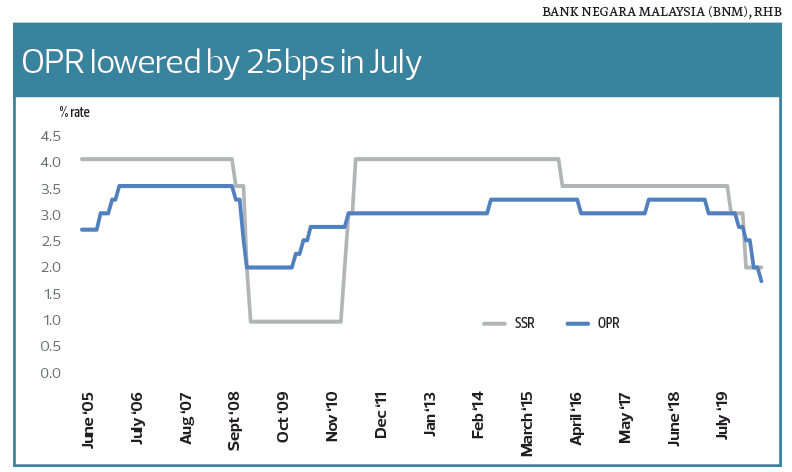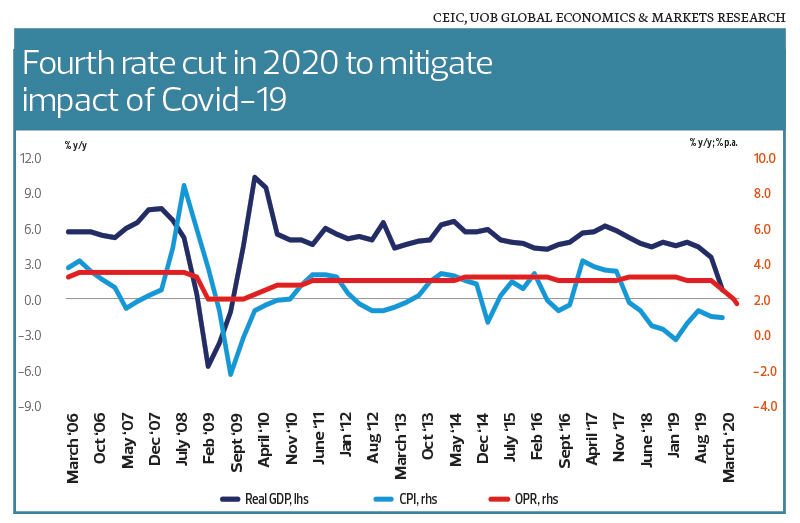
This article first appeared in The Edge Malaysia Weekly on July 13, 2020 - July 19, 2020
DURING the announcement of the first-quarter gross domestic product (GDP) results in May, Bank Negara Malaysia communicated that growth was expected to improve in the second half of the year, with economic activity resuming after the end of the Movement Control Order (MCO).
The central bank has now kicked off the second half with another reduction in the overnight policy rate (OPR). Last week’s 25-basis-point (bps) cut pushed the key rate to a historic low of 1.75% and highlighted the “severe” impact of the Covid-19 outbreak on the global economy.
Bank Negara also warned that downside risk will persist, especially if a second wave of the pandemic requires yet another round of lockdowns, given that major economies worldwide have begun to ease containment measures.
The monetary policy committee statement added that the reduction in interest rate was to “provide additional policy stimulus to accelerate the pace of economic recovery”.
From the hints, it appears likely that the central bank’s 2020 GDP projection of -2% to 0.5% will be revised, as the central bank said in May that any revision would be announced only in the second half, given the fluidity of the situation.
UOB Bank economist Julia Goh says in a report that Bank Negara’s 2020 growth projections were based on the assumption of a 1% contraction in global GDP. Obviously, much has changed since then.
“The latest International Monetary Fund (IMF) projection is for global GDP to contract 4.9% in 2020, which infers further downside risk for Bank Negara’s economic forecast,” Goh says, adding that IMF projects Malaysia’s economy to contract 3.8% in 2020 before rebounding to a 6.3% growth in 2021.
At this juncture, economic activities are expected to start recovering from their low point in the second quarter.
RHB Research economist Ahmad Nazmi Idrus says: “The second quarter should be the weakest, judging by the severe impact the initial MCO has caused. Moving ahead, even if Covid-19 cases rise, I think the government will try its best not to cause economic disruption of that scale.”
There is evidence of economic recovery at the moment. ACCIM’s Socio-economic Research Centre executive director Lee Heng Guie says channel checks show that most manufacturing plants have resumed operations at a utilisation rate of 70% to 80%, major shopping centres are seeing footfall of 50% to 70%, and sales are up 40% from pre-MCO levels. Besides, 98.8% of employees have returned to work.
Lee expects 2Q GDP to contract sharply by 11.5% y-o-y, as it bears the full brunt of the MCO.
“Consumer spending and businesses are slowly on the mend. A smaller magnitude of GDP decline (-3.4%) is expected in 3Q before reverting to 2.2% growth in 4Q,” he adds.
As economic activity starts to recover from the trough, Bank Negara says the improving economic outlook will be supported by the fiscal stimulus packages, together with monetary and financial measures.
So far, the government has doled out RM295 billion in fiscal stimulus packages, or the equivalent of 21.1% of GDP in 2020. On monetary measures, Maybank Investment Bank Research estimates that the central bank has injected a total of RM62 billion in liquidity through the 100bps cut to the statutory reserve requirement (SRR), flexibility in SRR compliance, reverse repo operations and Malaysian Government Securities purchases.
Still, Bank Negara cautions that the pace and strength of recovery would be subject to downside risk from both the domestic and external fronts.
“These include the prospect of further outbreaks of the pandemic leading to reimpositions of containment measures, more persistent weakness in labour market conditions, and a weaker-than-expected recovery in global growth,” it explains.
More rate cuts ahead?
Last week’s 25bps OPR cut was anticipated by most economists, but seven out of 25 had expected the central bank to keep the rate unchanged.
“I think Bank Negara’s perspective differs from ours in terms of the downside risk. It sees a greater possibility of a resurgence of an outbreak as [in] what is happening recently in countries like the US and how it will affect recovery going forward. If arguing on that front, then I think Bank Negara action is timely,” says Nazmi, who had not anticipated the cut.
Lee, who also expected rates to remain the same in July, says the rate cuts were made to keep the recovery phase more intact.
“There is still room [to cut rates], but I think the central bank will keep it for potential future shocks. I believe rates will be kept at 1.75% as the central bank monitors incoming data,” he says.
He also believes the 125bps reduction in OPR so far has largely helped relieve the debt servicing burden of existing borrowers.
“If the rate cuts help spur some growth, that’s good. But, most importantly, it eases the credit ratio of existing borrowers,” he adds.
Also in the minority group, UOB’s Goh now sees the possibility of another rate cut this year.
She says: “Given the projected deflation this year, the downside risk to the growth outlook, particularly if the pandemic effects persist, and with the US interest rates already near zero, I believe there is room to cut.
“However, it is also important to assess how much it can do to restart the economy and whether it is the right time to continue cutting rates.” She is cautious about the effectiveness of further cuts after the 125bps cut this year.
With interest rates at a record low, Goh says, it would make it more challenging to manoeuvre if a second wave hits or other negative surprises materialise.
“With continued rate cuts, if the outlook does not improve and uncertainty prevails, individuals and businesses would be hesitant to borrow, spend and invest. Moreover, given expectations that rates could come down further, some would prefer to wait and see,” she explains.
Save by subscribing to us for your print and/or digital copy.
P/S: The Edge is also available on Apple's App Store and Android's Google Play.
- China open to talks if Trump shows respect, names point person
- Sapura Energy bags multiple contracts worth nearly RM100 mil
- Anwar, Xi witness exchange of 31 MOUs and documents to advance Malaysia-China cooperation
- Bina Puri announces boardroom changes, founder director Tan Cheng Kiat retires
- King confident Malaysia, China will continue to empower cooperation
- Putrajaya orders temporary closure of KL Tower, says past concessionaire's stay 'unlawful'
- Meta saw TikTok as ‘highly urgent’ threat, Zuckerberg says at antitrust trial
- Sapura Industrial, Gas Malaysia, CapitaLand, Hextar Technologies, Golden Land, Skyworld, Sapura Energy, Bina Puri, Paragon Globe, OCK Group, Nextgreen, Nexgram
- Ivory Properties aborts land disposal deal with Chin Hin following liquidation of subsidiary
- Tesla slumps below 50% share of California’s electric car market


